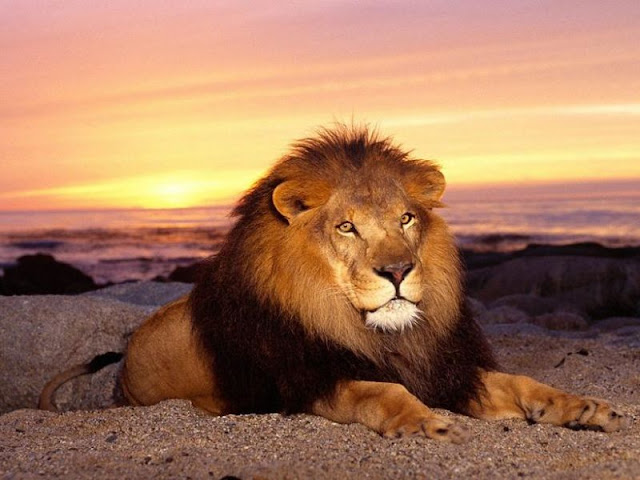Animal State | Lion | The biggest name, similar in many Romance languages, comes from Latin and ancient greek λέων Leo (Leon) is derived. Today only eight subspecies usually are accepted, even if one of these, the Cape lion, formerly known as Panthera leo melanochaita described, is probably not valid. While the state of the Asiatic lion (P. persica L.) is a subspecies universally accepted, the systematic relationships among the African lions are not yet fully understood. Mitochondrial variation in living African lion seems to be modest by some recent studies, therefore, all sub-Saharan lions were sometimes only as a subspecies. However, a recent study showed lions Western and Central Europe differ genetically from the lions of southern Africa and eastern Europe. According to this study, Western African lions are more closely related to lions in South Asian and East African lions. These results could be due to a late Pleistocene extinction of lions in West and Central Africa and the subsequent re-colonization of these parts from Asia are explained.
Lions of Tsavo East Kenya are much closer genetically to lions in Transvaal (South Africa), as in the Aberdare range in western Kenya. Another study found that there are three main types of lions, a North African Asian, a South African and Central Africa. The Asiatic lion was the most striking persica, and the Lion's Head was more allied with property P. persica L. compared to other sub-Saharan lions. He was 58 lions skull analyzed in three European museums, the lion is the highest (shoulder) of all cats, an average of about 14 cm (5.5 inches) larger than the tiger. Behind only the tiger, the lion is the second largest living felid in length and weight. The largest skull has large nasal openings that the tiger.
Lion coloration varies from fan light yellowish, reddish, yellow or dark brown. Lions are the only members of the cat family on hand, sexual dimorphism, males and females must be notified to appear noticeably different. The color of the male's mane varies from blond to black, usually darker is older than the lion. Weights for adult lions range from 150 to 250 kg (330-550 lb) for males and 120 to 182 kg (264-400 lb) for women. Nowell and Jackson report average weight of 181 kg (400 £) for males and 126 kg (280 lb) for women. Lions tend to vary in size depending on their environment and surrounding area, leading to a wide distribution of the weights recorded.
The longest known lion, with about 3.6 m (12 ft) in total length, was a black-maned male shot near Mucsso, southern Angola in October 1973, was the heaviest known lion to the wild in a man-eater 1936 before the doors Hectorspruit shot in Eastern Transvaal, South Africa and weighed 313 kg (690 lb). Another particularly large male lion that was shot near Mount Kenya, weighed 272 kg (600 lb). Lions in captivity is usually larger than the lion in the desert lion's heaviest ever recorded in Male Colchester Zoo in England named Simba in 1970, who weighed 375 kg (826 lb).
However, the head often cited maximum length of the body and can be adjusted from 250 cm (8 ft 2 in) and not to become extinct Pleistocene forms, such as the American lion, even with a large extent modern lion a few inches less in length The most striking characteristic of males and females have in common is that the tail ends in a hairy tuft. Lion hiding in some "encouraging" the shock of a hard "spine" or about 5 mm, consisting of the final sections of tail bone fused together. The lion is the only felid a tufted tail, the function of the tuft and spine are not known to have.
Even if the lions can be active at all times, their activity generally peaks after dusk with a period of socialization, grooming, and defecation. In Africa, lions in the savanna grasslands with scattered acacia trees, which is to serve as the shadow of its former habitats in India, a mixture of savannah and dry forest scrub very dry deciduous forest. The habitat of lions originally crossed the southern part of Eurasia, from Greece to India, and most of Africa except the central area of rain forest and the Sahara. A population of Asiatic lion survived until the tenth century in the Caucasus, their last European outpost. About 300 lions live in a 1412 km2 (545 square miles) sanctuary in Gujarat, which covers most of the forest.



















0 comments
Post a Comment